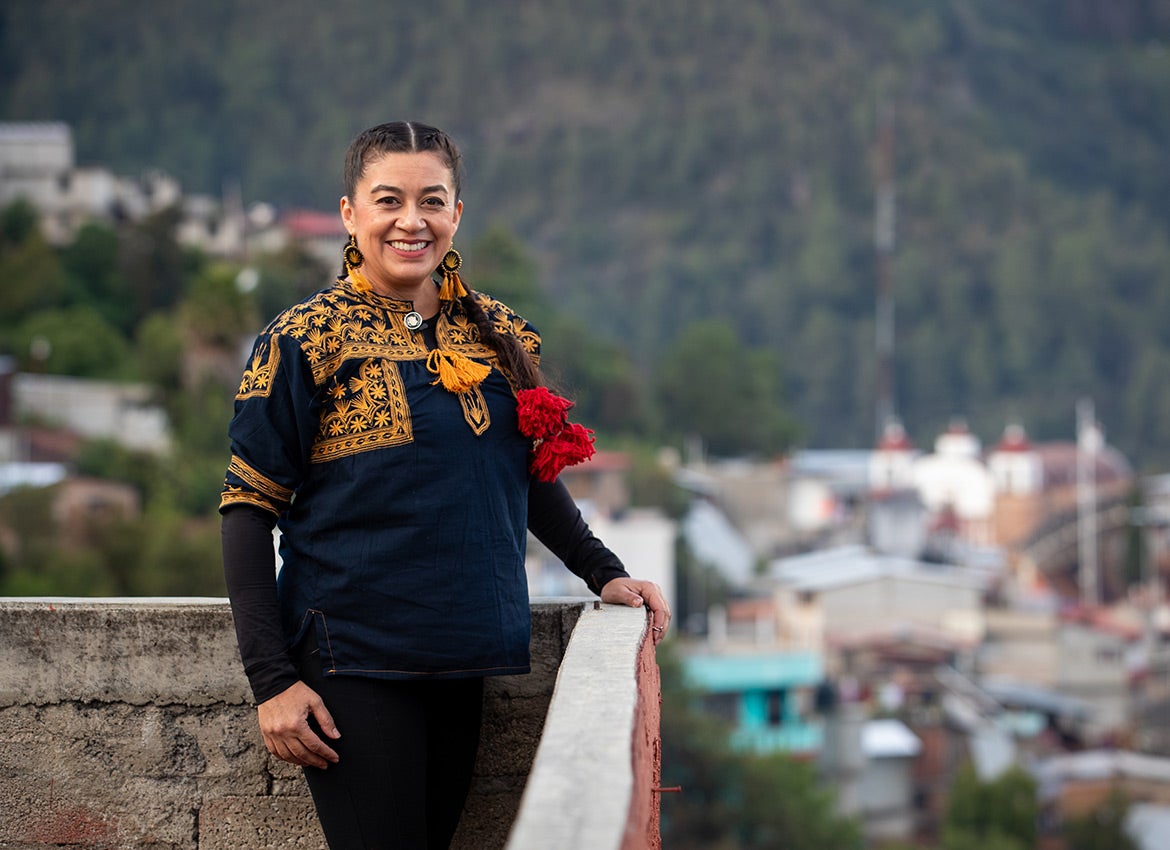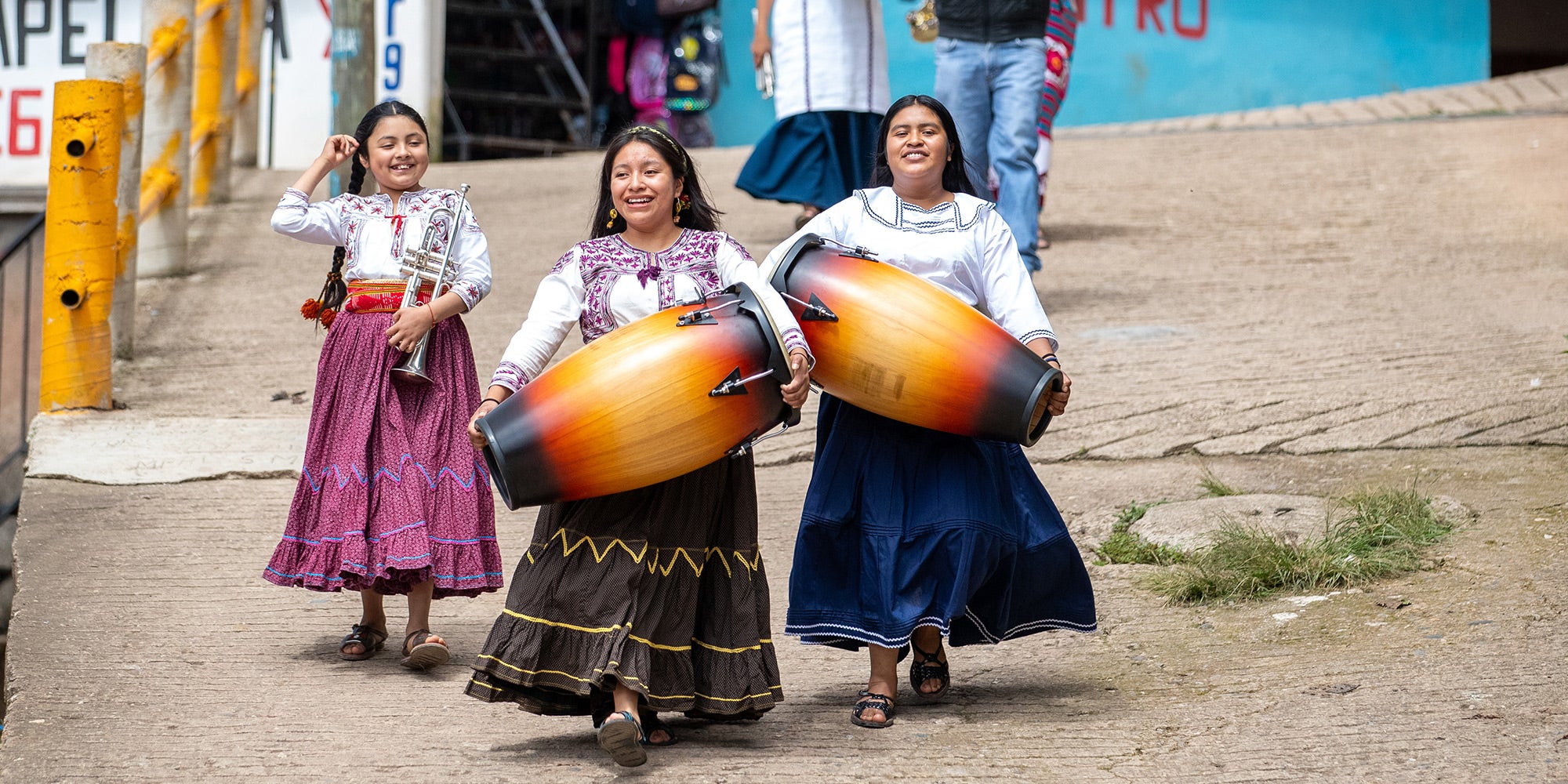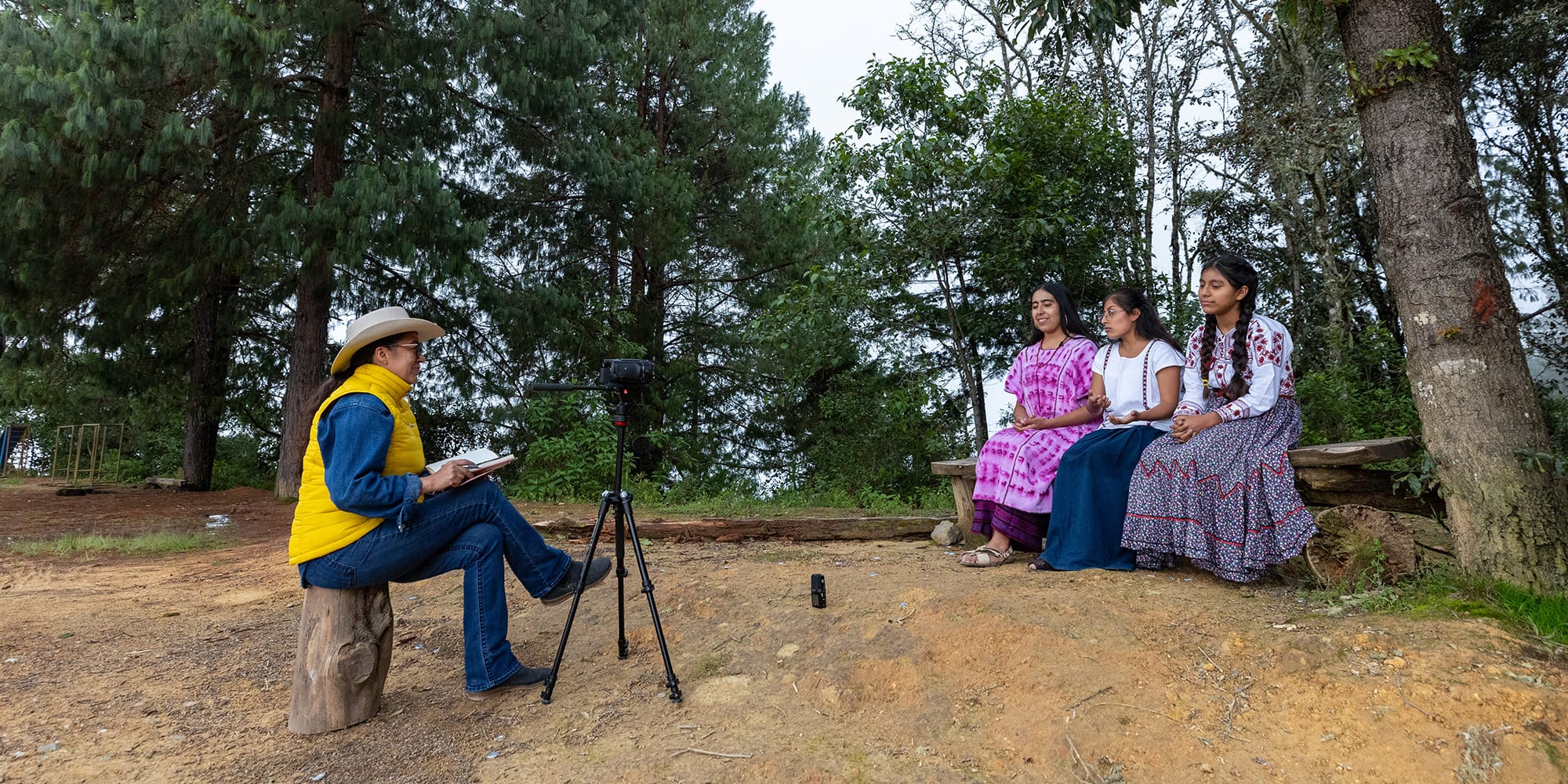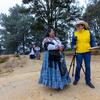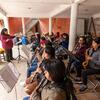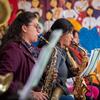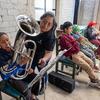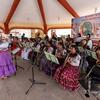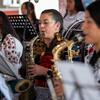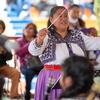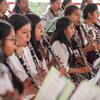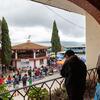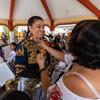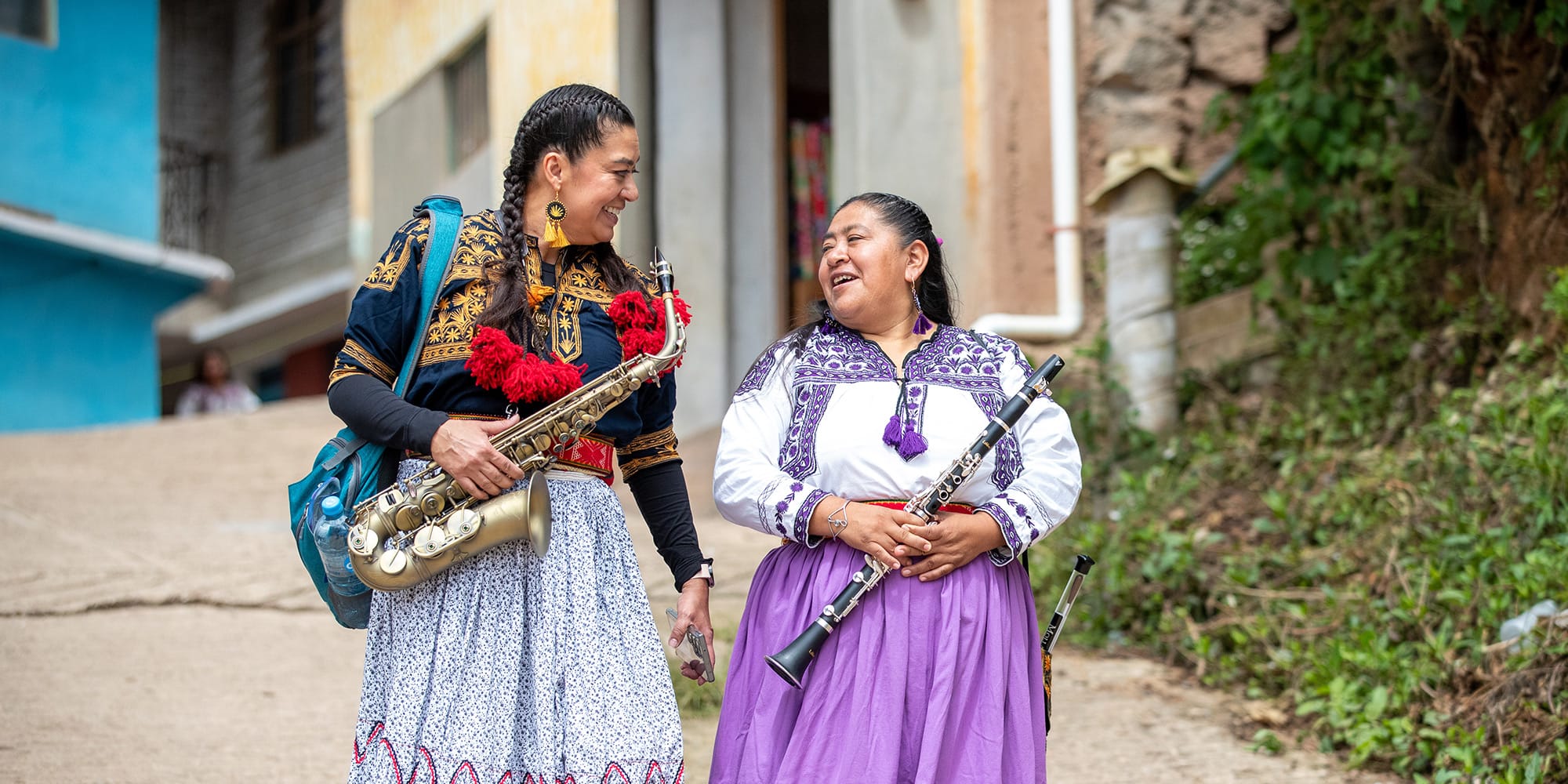THE Land of Musicians
Xóchitl Chávez, assistant professor of music, has been researching Oaxacan philharmonic bands for 15 years. This summer, she spent four days documenting the work of the all-female Indigenous band Mujeres del Viento Florido
By Sandra Baltazar Martínez | Photos by Stan Lim
S hortly before 4 p.m., the center of town reverberates with sounds of trumpets, cymbals, and clarinets. A steady stream of children with deep brown eyes and rosy cheeks — a product of the brisk mountain air — walk into various municipal classrooms. Strapped on their backs are tubas, snare drums, and saxophones. It’s a typical afternoon in late August in Santa Maria Tlahuitoltepec, a community sitting at 7,000-feet in elevation in the southern state of Oaxaca, Mexico.
At Leticia “Lety” Gallardo Martínez’s house, children, teens, and women arrive for music practice. During school hours, Gallardo Martínez teaches at the local elementary school. After class, she assumes another role: composer and music conductor of the all-female Indigenous philharmonic band Mujeres del Viento Florido. Since 2009, Gallardo Martínez has been building the band, made up of about 50 women ages 9 to 47.
“To my knowledge, we are the only band in the country with these characteristics: all-female, Indigenous, and regional, meaning we accept women from any community. This is what we are devoted to,” said Gallardo Martínez, who has a bachelor’s in education from the Universidad Pedagógica Nacional de Oaxaca, and another in art from the Instituto Multidisciplinario de Especialización in Oaxaca.
The philharmonic band has recorded four albums and its band members have traveled to perform in Amsterdam, Brazil, Spain, Chile, and across Mexico. They have accompanied artists such as Mexican singer-songwriter Lila Downs and, most recently, Chilean-Mexican musician Mon Laferte at the Lincoln Center in New York and Palacio de Bellas Artes in Mexico City. Mujeres del Viento Florido’s influence in Tlahuitoltepec, commonly known as Tlahui, has meant more professional careers for women — and for many, defying societal expectations such as marriage and childbearing.
“For Tlahuitoltepec residents, music is part of life — and even part of death,” Gallardo Martínez said. “Here you’ll listen to music every day, from morning to night. There is music played by female musicians as well, something that was not always true.”
Over the past 10 years, Mujeres del Viento Florido’s trajectory has been central to research conducted by Xóchitl Chávez, an assistant professor of music at UC Riverside. A cultural anthropologist and applied ethnomusicologist, Chávez is among the hundreds of UC faculty who have worked in Mexico or alongside Mexican faculty, a collaboration officially established between the UC and Mexico in 1980 called UC MEXUS (now part of Alianza MX). This past summer, Chávez spent two weeks conducting research in Oaxaca and Mexico City, including a four-day trip to document Mujeres del Viento Florido’s first-ever civic performance in Tlahui during a free community music program dubbed Sábado en Concierto.
At UCR, Chávez serves as the Department of Music coordinator for the UCR Gluck Fellows Program of the ARTS and faculty advisor to the Ballet Folklórico de UCR student dance club. In 2018, she brought more than 140 multigenerational philharmonic musicians to UCR for an inaugural Oaxacan philharmonic bands audition. Her first book, “The Guelaguetza: Performative Crossroads, Ethnicity, and Greater Oaxaca,” honors the annual Oaxacan culture and music festival, Guelaguetza, and will publish later this year.
“Music is a way of us conversing, whether its lyrics or instrumentation,” said Chávez, a saxophone player whose musical influence comes from her late father José Octavio Chávez, a Mexican immigrant from Chihuahua. “Music is the original form of communication to tell others what was happening in their communities.”
Her current research centers on the impact of Oaxacan music in the United States, including the flourishing number of Oaxacan bands in Los Angeles; a 2016 study indicates about 350,000 Oaxacans live in central and Southern California. This research, including on Mujeres del Viento Florido, will eventually culminate in Chávez’s second book.
“I’m looking at transnational migration of Indigenous Mexicans, specifically at the music and cultural migration of Oaxacans,” she said. “This continuous circuit that we see between Oaxaca and California, as well as to states such as North Carolina, New York, New Jersey, and Washington State, is impactful.”
Why be a Musician?
Upon her arrival in Tlahui in late August, Chávez set out to interview some of the women who make up Mujeres del Viento. Sitting on a tree trunk against the backdrop of verdant hills and evergreen pine trees, notepad in hand and camcorder on, she spends most of the day speaking to several of the band members. These women, and the rest of the band, speak Spanish as a second language; their mother tongues include Zapoteco, Mazateco, Mixteco, and Mixe. Mixe, also known as Ayuujk, is Tlahui’s native language.
Music is central in Tlahui, known as “the land of musicians.” In addition to supporting a strong basketball program for both children and adults, the City Council allocates resources to free after-school music classes and to its Indigenous music boarding school, Centro de Capacitación Musical y Desarrollo de la Cultura Mixe, or CECAM, which has been active since 1977. Tlahui has an estimated population of 10,000 and 15 philharmonic bands. City councilman Inocencio Pérez Jiménez noted the bimonthly Sábado en Concierto music program, which runs May through November, plays an important role in featuring community talent. It’s also a way to support women in the various roles they occupy in the community, he said.
But this choice of occupation has not always been viewed favorably. Historically, musicians in Tlahui were primarily male. It wasn’t until the 1980s that women began to join brass bands. Even then, they were only allowed to play “female appropriate” instruments such as the clarinet, because its wood mouthpiece, or reed, was thought to be gentler on a woman’s lips.
“I first played the soprano saxophone, then the trumpet,” said Virgen López Gallardo, one of the original members of Mujeres del Viento Florido. “I was one of the first ones to play a brass instrument. I love it.”
López Gallardo played with the band for four years before taking a recess when she got pregnant and rejoined in 2022. Her husband is supportive of this career choice, but other family members are critical, she said. They often say things like, “Why be a musician? It’s for men; they drink a lot. What are you doing there?” But the reality is much different — Mujeres del Viento Florido is a sisterhood.
“This is about demystifying the norms and breaking stereotypes about Indigenous communities.” — Xóchitl Chávez
For Hanlly Michelle Ruiz Ramírez, music is an opportunity to express and support women’s rights, as well as to reclaim cultural identity. Her family is from a coastal community in Oaxaca, but moved to Oaxaca City, where she grew up.
“It wasn’t until I joined the band that I asked myself, ‘Where am I from?’” said Ruiz Ramírez, who is working on a bachelor’s degree from Universidad Nacional Autónoma de México; her thesis is on linguistics, focusing on bilingual dictionaries for Spanish-Mixe. “With the move, there were lost traditions. I had to research what type of attire they wore and then wear those garments to represent my heritage during band performances.”
When Mujeres del Viento Florido was established in 2009, it had just two members. Then it quickly grew to 10, then 20, and now nears 50. The band did not have a budget for uniforms, so as band leader, Gallardo Martínez decided everyone should wear their Sunday best for their first performance. Every woman showed up in traditional attire and the audience loved their uniqueness, she said. She then insisted everyone research and understand the history behind each piece of clothing.
One of Gallardo Martínez’s main goals is that all women feel safe and accepted. She delegates responsibilities and has created a buddy system so bandmates are working together and looking out for each other. Another priority is creating as many opportunities as possible for performances and travel. Being a member of Mujeres del Viento Florido requires commitment and dedication, said Gallardo Martínez, a single mother of two.
“This is about demystifying the norms and breaking stereotypes about Indigenous communities,” Chávez said. “This is about taking a traditional European style of music that has become ‘Mexicanized’ and elevating it.”
Here to Serve
Between the day’s interviews, Chávez and the band members return for rehearsal on the first floor of Gallardo Martínez’s cinderblock house. The entire home is abuzz, with women and children moving through the space like flowing musical notes. On the third floor, music teacher Andrea Nataly Luis Pérez guides about 20 elementary school-aged children for a two-hour beginner’s class. In addition to leading Mujeres del Viento Florido, Gallardo Martínez now offers classes to boys and girls from the community. She is aided primarily by fellow band member Luis Pérez, a product of CECAM music school with more than a decade of professional experience. Luis Pérez is quiet, but as soon the instruments play, her 5-foot stature seems to swell with the music.
“Take it from the top and let’s do this again … 3, 4, pa-pa-pa,” said Luis Pérez, cueing the students as they sit overlooking the cirrus clouds drifting between mountain peaks.
Luis Pérez is preparing the group for its upcoming performance at a baptismal mass and party. Like dozens of Mujeres del Viento Florido band members, she is committed to teaching music in addition to playing. She travels to Tlahui for work Sunday nights, teaches in town through Friday afternoon, then catches a taxi to a community about three hours away to teach a youth band Saturdays and Sundays. It’s a circuit Luis Pérez has kept up for six years.
“It’s a huge commitment, but I love what I do — we are here to serve the community,” said Luis Pérez, alluding to the long-standing Indigenous practice of tequio, or the community service each person is expected to contribute; band performances inside Tlahui are considered tequio and are not compensated financially. “Music has taught me to be resilient. I’ve had to answer to comments such as ‘she’ll get married and abandon the job’ and ‘how is a woman going to teach me?’ With men, I’ve learned that you have to draw boundaries and respect space.”
With her fellow band members, however, Luis Pérez feels safe and assured.
“Playing alongside them is walking into a world without worries,” she said. “I forget everything, and I just focus on playing.”
Throughout her 15 years of research in Mexico, California, and other parts of the U.S., Chávez has witnessed the value of communal support, of chosen families who, despite migration, preserve culture and keep tequio as a central value. She makes sure to bring these lessons back home to her classes at UCR, assuring her students that Mexican music is just as valuable as classical music. Sometimes, she comes to class in Oaxacan attire or boots and cowboy hats.
“Growing up, my mom would say, ‘Ask how you can help.’” Chávez said. “I actually got to see the practice, the collective organized action of what tequio is, how community comes together towards that common goal.”
In Concert
Chávez concludes her first day in Tlahui with a total of eight interviews with the women of Mujeres del Viento Florido. At 10 p.m., she straps her saxophone bag around her chest along with the cameras and makes a 10-minute trek in the mist up a hilly street to her hotel.
By 8 a.m. the next morning, the sound of music again booms throughout Gallardo Martínez’s home, while streaks of sunlight hit the exterior walls painted in peach and crimson. In the kitchen on the second floor, a big pot of coffee brews atop a clay comal over burning wood and a bag of traditional pan de yema (yolk bread) sits out for guests. Perfect for the chilly morning.
In the home’s first floor rehearsal space, women find their respective chairs while Gallardo Martínez takes phone calls — last minute confirmations to ensure they have speakers and enough volunteers to set up chairs for the Sábado en Concierto performance the following day. Chávez, too, takes a seat, ready for the day-long practice. The band only takes a break for lunch and dinner.
On the day of the concert, Gallardo Martínez helps Chávez dress in traditional garb, educating her on the significance of items such as the colorful belt around her waist. Called a tsum in Ayuujk, the embroidered belt is made of palm fiber and is meant to protect a woman’s back and womb when they are carrying heavy items.
These Saturday afternoon concerts are a long-standing tradition in Tlahui. Featured bands play during the town’s bimonthly farmer’s market, surrounded by hundreds of vendors offering everything from furniture to sweet treats, live chickens, fruit, colorful dahlias, and much more. Mujeres del Viento Florido find their place in the town’s quiosco, a dome-shaped pavilion with an emblematic tuba and music note at its peak.
“Before, it was impossible to imagine that women were able to play wind instruments with such agility, other than flutes, clarinets, or saxophones. But with dedication and effort, in the past two decades, women have demonstrated otherwise,” said the Sábado en Concierto’s emcee in Spanish and Ayuujk.
Female musicians such as those in Mujeres del Viento Florido defy those antiquated beliefs. During the concert, they sat with regal posture, proudly wearing skirts, blouses, and earrings that represent their family’s Indigenous heritage. They played instruments such as tubas, trombones, saxhorn, and the sousaphone. The concert included a repertoire of 12 songs, all by Oaxacan composers or singers that profoundly connect Mexican life and culture.
The band also invited regional Mexican singer Geo Meneses and soprano Fany Leyva to the event. Their voices echoed like thunder, prompting people to sing and dance. Traditional songs such as “Moliendo Café,” “Llorona,” “Un día en Oaxaca,” “Cielito Lindo,” and “Chispita de Chocolate” resounded through all corners of town — and across borders, including in the U.S. where the live transmission was broadcast via popular Oaxaca radio station, Radio Comunitaria Jenpoj, 107.9 FM.
The concert was significant in many ways: It was the first time Mujeres del Viento Florido was a featured band; Gallardo Martínez was recognized as a changemaker by the Oaxaca-based nonprofit Fundación Soprano Fany Leyva; and, for the first time, Chávez was invited to join the band as a guest saxophone player.
“When we think about anthropologists or ethnomusicologists walking into a community and assuming a connection, that is not something I practice,” Chávez said. “Just because I have an instrument does not mean I can come sit down and play with them. When we think about Indigenous communities, any community, we have to be respectful. This is built on rapport; this is built on years of trust, of confianza. Years of accompaniment.”
